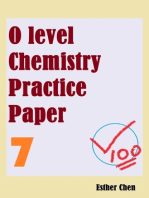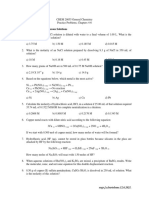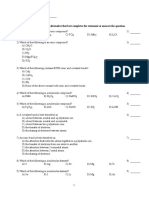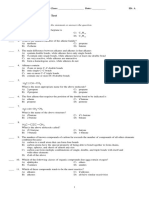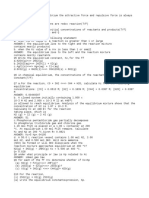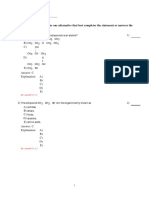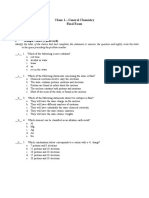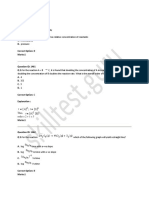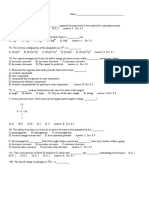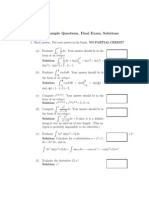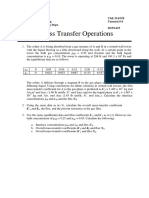Chapter 6
Chapter 6
Uploaded by
Joseph KfouryCopyright:
Available Formats
Chapter 6
Chapter 6
Uploaded by
Joseph KfouryOriginal Description:
Copyright
Available Formats
Share this document
Did you find this document useful?
Is this content inappropriate?
Copyright:
Available Formats
Chapter 6
Chapter 6
Uploaded by
Joseph KfouryCopyright:
Available Formats
Chapter 6: Thermochemistry
1. Radiant energy is
A) the energy stored within the structural units of chemical substances.
B) the energy associated with the random motion of atoms and molecules.
C) solar energy, i.e. energy that comes from the sun.
D) energy available by virtue of an object's position.
Ans: C Category: Easy Section: 6.1
2. Thermal energy is
A) the energy stored within the structural units of chemical substances.
B) the energy associated with the random motion of atoms and molecules.
C) solar energy, i.e. energy that comes from the sun.
D) energy available by virtue of an object's position.
Ans: B Category: Easy Section: 6.1
3. Chemical energy is
A) the energy stored within the structural units of chemical substances.
B) the energy associated with the random motion of atoms and molecules.
C) solar energy, i.e. energy that come s from the sun.
D) energy available by virtue of an object's position.
Ans: A Category: Easy Section: 6.1
4. Potential energy is
A) the energy stored within the structural units of chemical substances.
B) the energy associated with the random motion of atoms and molecules.
C) solar energy, i.e. energy that comes from the sun.
D) energy available by virtue of an object's position.
Ans: D Category: Easy Section: 6.1
5. Heat
A)
B)
C)
D)
is
a measure of temperature.
a measure of the change in temperature.
a measure of thermal energy.
a measure of thermal energy transferred between two bodies at different
temperature.
Ans: D Category: Medium Section: 6.2
6. An endothermic reaction causes the surroundings to
A) warm up.
D) decrease in temperature.
B) become acidic.
E)
release CO2 .
C) condense.
Ans: D Category: Easy Section: 6.2
Page 110
Chapter 6: Thermochemistry
7. An exothermic reaction causes the surroundings to
A) warm up.
D) decrease its temperature.
B) become acidic.
E)
release CO2 .
C) expand.
Ans: A Category: Easy Section: 6.2
8. Copper metal has a specific heat of 0.385 J/gC. Calculate the amount of heat required to
raise the temperature of 22.8 g of Cu from 20.0C to 875C.
A) 1.97 105 J B) 1.0 102 J C) 329 J D) 7.51 kJ E) 10.5 kJ
Ans: D Category: Medium Section: 6.5
9. Calculate the amount of heat necessary to raise the temperature of 12.0 g of water from
15.4C to 93.0C. The specific heat of water = 4.18 J/gC.
A) 0.027 J B) 324 J C) 389 J D) 931 J E) 3,890 J
Ans: E Category: Medium Section: 6.5
10. How much heat is required to raise the temperature of 2,500 g of water from 27C to
72C? The specific heat of water is 4.184 J/gC.
A) 0.19 kJ B) 10. kJ C) 280 kJ D) 470 kJ E) 750 kJ
Ans: D Category: Medium Section: 6.5
11. A beaker contains 115 g of ethanol at 18.2C. If the ethanol absorbs 1125 J of heat
without losing heat to the surroundings, what will be the final temperature of the ethanol?
The specific heat of ethanol is 2.46 J/gC.
A) 4.08C B) 14.1C C) 18.4C D) 22.2C E) 36.4C
Ans: D Category: Medium Section: 6.5
12. How many degrees of temperature rise will occur when a 25.0 g block of aluminum
absorbs 10.0 kJ of heat? The specific heat of Al is 0.900 J/gC.
A) 0.44C B) 22.5C C) 225C D) 360C E) 444C
Ans: E Category: Medium Section: 6.5
13. If 325 g of water at 4.2C absorbs 12.28 kJ, what is the final temperature of the water?
The specific heat of water is 4.184 J/gC.
A) 4.21C B) 4.8C C) 9.0C D) 13.2C E) 2,938C
Ans: D Category: Medium Section: 6.5
14. A glass containing 200. g of H2 O at 20C was placed in a refrigerator. The water loses
11.7 kJ as it cools to a constant temperature. What is its new temperature? The specific
heat of water is 4.184 J/gC.
A) 0.013C B) 4C C) 6C D) 14C E) 34C
Ans: C Category: Medium Section: 6.5
Page 111
Chapter 6: Thermochemistry
15. A piece of copper with a mass of 218 g has a heat capacity of 83.9 J/C. What is the
specific heat of copper?
A) 0.385 J/gC
D) 1.32 J/gC
4
B) 1.83 10 J/gC
E)
24.5 J/gC
C) 2.60 J/gC
Ans: A Category: Easy Section: 6.5
16. The specific heat of gold is 0.129 J/gC. What is the molar heat capacity of gold?
A) 0.039 J/molC
D) 39.0 kJ/molC
B) 0.129 J/molC
E)
197 J/molC
C) 25.4 J/molC
Ans: C Category: Easy Section: 6.5
17. Suppose a 50.0 g block of silver (specific heat = 0.2350 J/gC) at 100C is placed in
contact with a 50.0 g block of iron (specific heat = 0.4494 J/gC) at 0C, and the two
blocks are insulated from the rest of the universe. The final temperature of the two
blocks
A) will be higher than 50C.
B) will be lower than 50C.
C) will be exactly 50C.
D) is unrelated to the composition of the blocks.
E)
cannot be predicted.
Ans: B Category: Medium Section: 6.5
18. When 0.7521 g of benzoic acid was burned in a calorimeter containing 1,000. g of water,
a temperature rise of 3.60C was observed. What is the heat capacity of the bomb
calorimeter, excluding the water? The heat of combustion of benzoic acid is 26.42 kJ/g.
A) 15.87 kJ/C
D) 1.34 kJ/C
B) 4.18 kJ/C
E)
752.1 kJ/C
C) 5.52 kJ/C
Ans: D Category: Medium Section: 6.5
19. Naphthalene combustion can be used to calibrate the heat capacity of a bomb calorimeter.
The heat of combustion of naphthalene is 40.1 kJ/g. When 0.8210 g of naphthalene was
burned in a calorimeter containing 1,000. g of water, a temperature rise of 4.21C was
observed. What is the heat capacity of the bomb calorimeter excluding the water?
A) 32.9 kJ/C B) 7.8 kJ/C C) 3.64 kJ/C D) 1.76 kJ/C E) 15.3 kJ/C
Ans: C Category: Medium Section: 6.5
20. Which of the following processes is endothermic?
A) O2 (g) + 2H2 (g) 2H2 O(g)
B) H2 O(g) H2 O(l)
C) 3O2 (g) + 2CH3 OH(g) 2CO2 (g) + 2H2 O(g)
D) H2 O(s) H2 O(l)
Ans: D Category: Medium Section: 6.4
Page 112
Chapter 6: Thermochemistry
21. A 100. mL sample of 0.200 M aqueous hydrochloric acid is added to 100. mL of 0.200 M
aqueous ammonia in a calorimeter whose heat capacity (excluding any water) is 480. J/K.
The following reaction occurs when the two solutions are mixed.
HCl(aq) + NH3 (aq) NH4 Cl(aq)
The temperature increase is 2.34C. Calculate H per mole of HCl and NH3 reacted.
A) 154 kJ/mol
D) 1.96 kJ/mol
B) 1.96 kJ/mol
E)
154 kJ/mol
C) 485 kJ/mol
Ans: E Category: Difficult Section: 6.5
22. A 0.1326 g sample of magnesium was burned in an oxygen bomb calorimeter. The total
heat capacity of the calorimeter plus water was 5,760 J/C. If the temperature rise of the
calorimeter with water was 0.570C, calculate the enthalpy of combustion of magnesium.
Mg(s) + 1/2O2 (g) MgO(s)
A) 3280 kJ/mol
D) 106 kJ/mol
B) 24.8 kJ/mol
E)
602 kJ/mol
C) 435 kJ/mol
Ans: E Category: Difficult Section: 6.5
23. To which one of the following reactions occurring at 25C does the symbol
Hf[H2 SO4 (l)] refer?
A) 2H(g) + S(g) + 4O(g) H2 SO4 (l)
D) H2 SO4 (l) 2H(g) + S(s) + 4O(g)
B) H2 (g) + S(g) + 2O2 (g) H2 SO4 (l)
E)
H2 (g) + S(s) + 2O2 (g) H2 SO4 (l)
C) H2 SO4 (l) H2 (g) + S(s) + 2O2 (g)
Ans: E Category: Medium Section: 6.6
24. To which one of the following reactions occurring at 25C does the symbol
Hf[HNO3 (l)] refer?
A) H(g) + N(g) + O3 (g) HNO3 (l)
B) (1/2)H2 (g) + (1/2)N 2 (g) + (3/2)O 2 (g) HNO3 (l)
C) HNO3 (l) (1/2)H2 (g) + (1/2)N 2 (g) + (3/2)O 2 (g)
D) HNO3 (l) H(g) + N(g) + 3O(g)
E)
H2 (g) + N2 (g) + O3 (g) HNO3 (l)
Ans: B Category: Medium Section: 6.6
25. When 0.560 g of Na(s) reacts with excess F2 (g) to form NaF(s), 13.8 kJ of heat is evolved
at standard-state conditions. What is the standard enthalpy of formation (Hf) of
NaF(s)?
A) 24.8 kJ/mol
D) 7.8 kJ/mol
B) 570 kJ/mol
E)
-570 kJ/mol
C) 24.8 kJ/mol
Ans: E Category: Medium Section: 6.6
Page 113
Chapter 6: Thermochemistry
26. When 18.5 g of HgO(s) is decomposed to form Hg(l) and O2 (g), 7.75 kJ of heat is
absorbed at standard-state conditions. What is the standard enthalpy of formation (Hf)
of HgO(s)?
A) 90.7 kJ/mol
D) 27.9 kJ/mol
B) 7.75 kJ/mol
E)
143 kJ/mol
C) 0.419 kJ/mol
Ans: A Category: Medium Section: 6.6
27. Ethanol undergoes combus tion in oxygen to produce carbon dioxide gas and liquid water.
The standard heat of combustion of ethanol, C2 H5 OH(l), is 1366.8 kJ/mol. Given that
Hf[CO2 (g)] = 393.5 kJ/mol and Hf[H2 O(l)] = 285.8 kJ/mol, what is the standard
enthalpy of formation of ethanol?
A) 3,010 kJ/mol
D) 687.6 kJ/mol
B) 687.6 kJ/mol
E)
1,367 kJ/mol
C) 277.6 kJ/mol
Ans: C Category: Difficult Section: 6.6
28. Find the standard enthalpy of formation of ethylene, C2 H4 (g), given the following data:
heat of combustion of C2 H4 (g) = 1411 kJ/mol; Hf[CO2 (g)] = 393.5 kJ/mol;
Hf[H2 O(l)] = 285.8 kJ/mol.
A) 52 kJ/mol
D) 1.41 103 kJ/mol
B) 87 kJ/mol
E)
2.77 103 kJ/mol
C) 731 kJ/mol
Ans: A Category: Difficult Section: 6.6
29. Octane (C 8 H18 ) undergoes combustion according to the following thermochemical
equation:
2C8 H18 (l) + 25O2 (g) 16CO2 (g) + 18H2 O(l)
Hrxn = 11,020 kJ/mol.
Given that Hf[CO2 (g)] = 393.5 kJ/mol and Hf[H2 O(l)] = 285.8 kJ/mol, calculate
the standard enthalpy of formation of octane.
A) 210 kJ/mol
D) 420 kJ/mol
B) 11,230 kJ/mol
E)
420 kJ/mol
C) 22,040 kJ/mol
Ans: A Category: Medium Section: 6.6
30. Glycine, C2 H5 O2 N, is important for biological energy. The combustion reactio n of
glycine is given by the equation
4C2 H5O2N(s) + 9O2 (g) 8CO2 (g) + 10H2 O(l) + 2N2 (g)
Hrxn = 3857 kJ/mol
Given that Hf[CO2 (g)] = 393.5 kJ/mol and Hf[H2 O(l)] = 285.8 kJ/mol, calculate
the enthalpy of formation of glycine.
A) 537.2 kJ/mol
D) 3,178 kJ/mol
B) 268.2 kJ/mol
E)
964 kJ/mol
C) 2,149 kJ/mol
Ans: A Category: Medium Section: 6.6
Page 114
Chapter 6: Thermochemistry
31. Styrene, C8 H8 , is one of the substances used in the production of synthetic rubber. When
styrene burns in oxygen to form carbon dioxide and liquid water under standard-state
conditions at 25C, 42.62 kJ are released per gram of styrene. Find the standard enthalpy
of formation of styrene at 25C.
(Given: Hf[CO2 (g)] = 393.5 kJ/mol, Hf[H2 O(l)] = 285.8 kJ/mol, Hf[H2 O(g)] =
241.8 kJ/mol)
A) 323.8 kJ/mol
D) ~636.7 kJ/mol
B) ~4249 kJ/mol
E)
147.8 kJ/mol
C) ~8730 kJ/mol
Ans: E Category: Difficult Section: 6.6
32. Given 2Al(s) + (3/2)O 2 (g) Al2 O3 (s), Hf = 1,670 kJ/mol for Al2 O3 (s).
Determine H for the reaction 2Al2 O3 (s) 4Al(s) + 3O2 (g).
A) 3,340 kJ/mol
D) 1,670 kJ/mol
B) 1,670 kJ/mol
E)
835 kJ/mol
C) 3,340 kJ/mol
Ans: A Category: Easy Section: 6.6
33. Calculate the standard enthalpy of formation of liquid methanol, CH3 OH(l), using the
following information:
C(graph) + O2 CO2 (g)
H = 393.5 kJ/mol
H2 (g) + (1/2)O 2 H2 O(l)
H = 285.8 kJ/mol
CH3 OH(l) + (3/2)O 2 (g) CO2 (g) + 2H2 O(l)
H = 726.4 kJ/mol
A)
B)
C)
Ans:
1,691.5 kJ/mol
238.7 kJ/mol
1691.5 kJ/mol
B Category: Difficult
D)
E)
47.1 kJ/mol
47.1 kJ/mol
Section: 6.6
34. Calculate the standard enthalpy change for the reaction
2C8 H18 (l) + 17O2 (g) 16CO(g) + 18H2 O(l).
Given:
2C8 H18 (l) + 25O2 (g) 16CO2 (g) + 18H2 O(l) H = 11,020 kJ/mol
2CO(g) + O2 (g) 2CO2 (g)
H = 566.0 kJ/mol
A) 10,450 kJ/mol
D) 6,492 kJ/mol
B) 6,492 kJ/mol
E)
10.450 kJ/mol
C) 15,550 kJ/mol
Ans: D Category: Medium Section: 6.6
Page 115
Chapter 6: Thermochemistry
35. During volcanic eruptions, hydrogen sulfide gas is given off and oxidized by air
according to the following chemical equation:
2H2 S(g) + 3O2 (g) 2SO2 (g) + 2H2 O(g)
Calculate the standard enthalpy change for the above reaction given:
3S(s) + 2H2 O(g) 2H2 S(g) + SO2 (g)
H = 146.9 kJ/mol
S(s) + O2 (g) SO2 (g)
H = 296.4 kJ/mol
A)
B)
C)
Ans:
1036.1 kJ/mol
742.3 kJ/mol
149.5 kJ/mol
A Category: Medium
D)
E)
443.3 kJ/mol
742.3 kJ/mol
Section: 6.6
36. Calculate the standard enthalpy change for the reaction
2C8 H18 (l) + 21O2 (g) 8CO(g) + 8CO2 (g) + 18H2 O(l).
Given:
2C8 H18 (l) + 25O2 (g) 16CO2 (g) + 18H2 O(l) H = 11,020 kJ/mol
2CO(g) + O2 (g) 2CO2 (g)
H = 566.0 kJ/mol
4
A) 1.0454 10 kJ/mol
D) 6,492 kJ/mol
B) 8,756 kJ/mol
E)
1.0454 104 kJ/mol
C) 1.1586 104 kJ/mol
Ans: B Category: Medium Section: 6.6
37. Given the thermochemical equation 2SO2 + O2 2SO3 , Hrxn = 198 kJ/mol,
what is the standard enthalpy change for the decomposition of one mole of SO3 ?
A) 198 kJ/mol
D) 396 kJ/mol
B) 99 kJ/mol
E)
198 kJ/mol
C) 99 kJ/mol
Ans: C Category: Medium Section: 6.6
38. Given H2 (g) + (1/2)O 2 (g) H2 O(l), H = 286 kJ/mol, determine the standard enthalpy
change for the reaction 2H2 O(l) 2H2 (g) + O2 (g).
A) H = 286 kJ/mol
D) H = +572 kJ/mol
B) H = +286 kJ/mol
E)
H = 143 kJ/mol
C) H = 572 kJ/mol
Ans: D Category: Easy Section: 6.6
Page 116
Chapter 6: Thermochemistry
39. Pentaborane B5 H9 (s) burns vigorously in O2 to give B2 O3 (s) and H2 O(l). Calculate Hrxn
for the combustion of 1 mol of B5 H9 .
Hf[B2 O3 (s)] = 1,273.5 kJ/mol
Hf[B5 H9 (s)] = 73.2 kJ/mol
Hf[H2 O(l)] = 285.8 kJ/mol
A) 1,2735 kJ/mol
D) 9,086 kJ/mol
B) 4,543 kJ/mol
E)
8,448 kJ/mol
C) 18,170 kJ/mol
Ans: B Category: Difficult Section: 6.6
40. For the reaction
C(graphite) + O2 (g) CO2 (g)
H = 393 kJ/mol
how many grams of C(graphite) must be burned to release 275 kJ of heat?
A) 22.3 g B) 0.70 g C) 12.0 g D) 17.1 g E) 8.40 g
Ans: E Category: Medium Section: 6.4
41. The combustion of butane produces heat according to the equation
2C4 H10 (g) + 13O2 (g) 8CO2 (g) + 10H2 O(l) Hrxn = 5,314 kJ/mol
What is the heat of combustion per gram of butane?
A) 32.5 kJ/g
D) 2,656 kJ/g
B) 45.7 kJ/g
E)
15,440 kJ/g
C) 91.5 kJ/g
Ans: B Category: Medium Section: 6.4
42. The combustion of octane produces heat according to the equation
2C8 H18 (l) + 25O2 (g) 16CO2 (g) + 18H2 O(l) Hrxn= 11,020 kJ/mol
What is the heat of combustion per gram of octane?
A) 5,510 kJ/g
D) 193 kJ/g
B) 96.5 kJ/g
E)
6.292 105 kJ/g
C) 48.2 kJ/g
Ans: C Category: Medium Section: 6.4
43. The combustion of butane produces heat according to the equation
2C4 H10 (g) + 13O2 (g) 8CO2 (g) + 10H2 O(l) Hrxn= 5,314 kJ/mol
How many grams of butane must be burned to release 1.00 104 kJ of heat?
A) 30.9 g B) 61.8 g C) 109 g D) 153 g E) 219 g
Ans: E Category: Medium Section: 6.4
44. The combustion of butane produces heat according to the equation
2C4 H10 (g) + 13O2 (g) 8CO2 (g) + 10H2 O(l) Hrxn= 5,314 kJ/mol
How many grams of CO2 are produced per 1.00 104 kJ of heat released?
A) 23.4 g B) 44.0 g C) 82.3 g D) 187 g E) 662 g
Ans: E Category: Medium Section: 6.4
Page 117
Chapter 6: Thermochemistry
45. Given that CaO(s) + H2 O(l) Ca(OH)2 (s), Hrxn = 64.8 kJ/mol, how many grams of
CaO must react in order to liberate 525 kJ of heat?
A) 6.92 g B) 56.1 g C) 455 g D) 606 g E) 3.40 104 g
Ans: C Category: Medium Section: 6.4
46. The combustion of pentane produces heat according to the equation
C5 H12 (l) + 8O2 (g) 5CO2 (g) + 6H2 O(l)
Hrxn= 3,510 kJ/mol
How many grams of CO2 are produced per 2.50 103 kJ of heat released?
A) 0.0809 g B) 3.56 g C) 31.3 g D) 157 g E) 309 g
Ans: D Category: Medium Section: 6.4
47. An average home in Colorado requires 20. GJ of heat per month. How many grams of
natural gas (methane) must be burned to supply this energy?
CH4 (g) + 2O2 (g) CO2 (g) + 2H2 O(l) Hrxn= 890.4 kJ/mol
A) 1.4 103 g
D) 2.2 104 g
5
B) 3.6 10 g
E)
1.4 104 g
C) 7.1 104 g
Ans: B Category: Medium Section: 6.4
48. Given the thermochemical equation 2SO2 (g) + O2 (g) 2SO3 (g), Hrxn= 198 kJ/mol,
how much heat is evolved when 600. g of SO2 is burned?
A) 5.46 102 kJ
D) 59,400 kJ
B) 928 kJ
E)
3.71 103 kJ
C) 1.85 103 kJ
Ans: B Category: Medium Section: 6.4
49. Determine the heat given off to the surroundings when 9.0 g of aluminum reacts
according to the equation 2Al + Fe2 O3 Al2 O3 + 2Fe, Hrxn= 849 kJ/mol.
A) 7.6 103 kJ
D) 5.6 102 kJ
2
B) 2.8 10 kJ
E)
2.5 103 kJ
C) 1.4 102 kJ
Ans: C Category: Medium Section: 6.4
50. Find the heat absorbed from the surroundings when 15 g of O2 reacts according to the
equation O + O2 O3 , Hrxn = 103 kJ/mol.
A) 4.6 103 kJ B) 48 kJ C) 96 kJ D) 32 kJ E) 110 kJ
Ans: B Category: Medium Section: 6.4
51. Ethanol (C 2 H5 OH) burns according to the equation
C2 H5OH(l) + 3O2 (g) 2CO2 (g) + 3H2 O(l), Hrxn = 1367 kJ/mol.
How much heat is released when 35.0 g of ethanol is burned?
A) 1,797 kJ B) 1,367 kJ C) 9.61 104 kJ D) 4.78 104 kJ E) 1,040 kJ
Ans: E Category: Medium Section: 6.4
Page 118
Chapter 6: Thermochemistry
52. Methanol (CH3 OH) burns according to the equation
2CH3 OH(l) + 3O2 (g) 2CO2 (g) + 4H2 O(l), Hrxn = 1454 kJ/mol.
How much heat, in kilojoules, is given off when 75.0 g of methanol is burned?
A) 727 kJ
D) 1.70 103 kJ
3
B) 3.22 10 kJ
E)
3.41 103 kJ
C) 1.45 103 kJ
Ans: D Category: Medium Section: 6.4
53. Calcium oxide and water react in an exothermic reaction:
CaO(s) + H2 O(l) Ca(OH)2 (s) Hrxn = 64.8 kJ/mol
How much heat would be liberated when 7.15 g CaO(s) is dropped into a beaker
containing 152g H2 O?
A) 1.97 103 kJ B) 8.26 kJ C) 508 kJ D) 547 kJ E) 555 kJ
Ans: B Category: Medium Section: 6.4
54. Solid sodium peroxide (Na2 O2 ) reacts with liquid water yielding aqueous sodium
hydroxide and oxygen gas. How much heat is released when 250.0 L of oxygen gas is
produced from the reaction of sodium peroxide and water if the reaction is carried out in
an open container at 1.000 atm pressure and 25C?
(Given: Hf[Na2 O2 (s)] = 510.9 kJ/mol; Hf[NaOH(aq)] = 469.2 kJ/mol;
Hf[H2 O(l)] = 285.8 kJ/mol)
A) 35,400 kJ B) 1740 kJ C) 141.7 kJ D) 3330 kJ E) 2900 kJ
Ans: E Category: Difficult Section: 6.6
55. At 25C, the standard enthalpy of formation of KCl(s) is 435.87 kJ/mol. When one
mole of KCl(s) is formed by reacting potassium vapor and chlorine gas at 25C, the
standard enthalpy of reaction is 525.86 kJ/mol. Find H for the sublimation of
potassium, K(s) K(g), at 25C.
A) 345.88 kJ/mol
D) 89.99 kJ/mol
B) 45.00 kJ/mol
E)
525.86 kJ/mol
C) 345.88 kJ/mol
Ans: D Category: Medium Section: 6.6
56. At 25C, the standard enthalpy of formation of anhydrous sodium carbonate is 1130.9
kJ/mol, whereas the standard enthalpy of formation of sodium carbonate monohydrate is
1430.1 kJ/mol. Determine H at 25C for the reaction
Na2 CO3 (s) + H2 O(l) Na2 CO3 H2 O(s).
(Given: Hf[H2 O(l)] = 285.8 kJ/mol)
A) 13.4 kJ/mol
D) 299.2 kJ/mol
B) 285.8 kJ/mol
E)
156.3 kJ/mol
C) 585.0 kJ/mol
Ans: A Category: Medium Section: 6.6
Page 119
Chapter 6: Thermochemistry
57. According to the first law of thermodynamics:
A) Energy is neither lost nor gained in any energy transformations.
B) Perpetual motion is possible.
C) Energy is conserved in quality but not in quantity.
D) Energy is being created as time passes. We have more energy in the universe now
than when time began.
Ans: A Category: Easy Section: 6.3
58. The heat of solution of KCl is 17.2 kJ/mol and the lattice energy of KCl(s) is 701.2
kJ/mol. Calculate the total heat of hydration of 1 mol of gas phase K+ ions and Cl ions.
A) 718 kJ B) 684 kJ C) 684 kJ D) 718 kJ E) None of these.
Ans: C Category: Medium Section: 6.7
59. The heat of solution of LiCl is 37.1 kJ/mol, and the lattice energy of LiCl(s) is 828
kJ/mol. Calculate the total heat of hydration of 1 mol of gas phase Li+ ions and Cl ions.
A) 791 kJ B) 865 kJ C) 865 kJ D) 791 kJ E) None of these.
Ans: C Category: Medium Section: 6.7
60. The total heat of hydration of 1 mol of gas phase Li+ ions and Cl ions is 865 kJ. The
lattice energy of LiCl(s) is 828 kJ/mol. Calculate the heat of solution of LiCl.
A) 37 kJ/mol
D) 37 kJ/mol
B) 1,693 kJ/mol
E)
None of these.
C) 1,693 kJ/mol
Ans: D Category: Medium Section: 6.7
61. 10.1 g CaO is dropped into a styrofoam coffee cup containing 157 g H2 O at 18.0C.
If the following reaction occurs, then what temperature will the water reach, assuming
that the cup is a perfect insulator and that the cup absorbs only a negligible amount of
heat? (the specific heat of water = 4.18 J/gC)
CaO(s) + H2 O(l) Ca(OH)2 (s) Hrxn = 64.8 kJ/mol
A) 18.02C B) 35.8C C) 311C D) 42.2C E) 117C
Ans: B Category: Medium Section: 6.5
62. The enthalpy change when a strong acid is neutralized by strong base is 56.1 kJ/mol. If
135 mL of 0.450 M HI at 23.15C is mixed with 145 mL of 0.500 M NaOH, also at
23.15C, what will the maximum temperature reached by the resulting solution? (Assume
that there is no heat loss to the container, that the specific heat of the final solution is 4.18
J/gC, and that the density of the final solution is that of water.)
A) 26.06C B) 29.19C C) 32.35C D) 20.24C E) 36.57C
Ans: A Category: Difficult Section: 6.5
Page 120
Chapter 6: Thermochemistry
63. The enthalpy change when a strong acid is neutralized by strong base is 56.1 kJ/mol. If
12.0 mL of 6.00 M HBr at 21.30C is mixed with 300. mL of 0.250 M NaOH, also at
21.30C, what will the maximum temperature reached by the resulting solution? (Assume
that there is no heat loss to the container, that the specific heat of the final solution is 4.18
J/gC, and that the density of the final solution is that of water.)
A) 18.20C B) 24.53C C) 101.8C D) 24.40C E) 34.25C
Ans: D Category: Difficult Section: 6.5
64. Calculate the amount of work done, in joules, when 2.5 mole of H2 O vaporizes at 1.0 atm
and 25C. Assume the volume of liquid H2 O is negligible compared to that of vapor. (1
Latm = 101.3 J)
A) 6,190 kJ B) 6.19 kJ C) 61.1 J D) 5.66 kJ E) 518 J
Ans: B Category: Medium Section: 6.3
65. A gas is compressed in a cylinder from a volume of 20.0 L to 2.0 L by a constant
pressure of 10.0 atm. Calculate the amount of work done on the system.
A) 1.01 104 J B) 180 J C) 1.81 104 J D) 1.81 104 J E) 180 J
Ans: C Category: Medium Section: 6.3
66. Calculate the amount of work done against an atmospheric pressure of 1.00 atm when
500.0 g of zinc dissolves in excess acid at 30.0C.
Zn(s) + 2H+ (aq) Zn2+(aq) + H2 (g)
A) w = +22.4 kJ
D) w = 2.52 kJ
B) w = +24.9 kJ
E)
w = 19.3 kJ
C) w = 0
Ans: E Category: Medium Section: 6.3
67. A gas is allowed to expand, at constant temperature, from a volume of 1.0 L to 10.1 L
against an external pressure of 0.50 atm. If the gas absorbs 250 J of heat from the
surroundings, what are the values of q, w, and E?
Ans: A
Category: Medium
Section: 6.3
Page 121
Chapter 6: Thermochemistry
68. Which of the following processes always results in an increase in the energy of a system?
A) The system loses heat and does work on the surroundings.
B) The system gains heat and does work on the surroundings.
C) The system loses heat and has work done on it by the surroundings.
D) The system gains heat and has work done on it by the surroundings.
E)
None of these is always true.
Ans: D Category: Medium Section: 6.3
69. For which of these reactions will the difference between H and E be the greatest?
A) 2H2 O2 (l) 2H2 O(l) + O2 (g)
B) CaCO3 (s) CaO(s) +CO2 (g)
C) NO(g) + O3 (g) NO2 (g) + O2 (g)
D) 2C2 H6 (g) + 7O2 (g) 4CO2 (g) + 6H2 O(l)
E)
4NH3 (g) + 5O2 (g) 4NO(g) + 6H2 O(g)
Ans: D Category: Medium Section: 6.4
70. For which of these reactions will the difference between H and E be the smallest?
A) N2 (g) + 3H2 (g) 2NH3 (g)
B) 4PH3 (g) P4 (g) + 6H2 (g)
C) H2 (g) + Cl2 (g) 2HCl(g)
D) CO2 (g) + 2H2 O(l) CH4 (g) + 2O2 (g)
E)
P4 (s) + 10Cl2 (g) 4PCl5 (s)
Ans: C Category: Medium Section: 6.4
71. At 25C, the following heats of reaction are known:
2ClF(g) + O2 (g) Cl2 O(g) + F2 O(g)
Hrxn = 167.4 kJ/mol
2ClF 3 (g) + 2O2 (g) Cl2 O(g) + 3F2 O(g)
Hrxn = 341.4 kJ/mol
2F2 (g) + O2 (g) 2F2 O(g)
Hrxn = 43.4 kJ/mol
At the same temperature, use Hess's law to calculate Hrxn for the reaction:
ClF(g) + F2 (g) ClF 3 (g)
A) 217.5 kJ/mol
D) 108.7 kJ/mol
B) 130.2 kJ/mol
E)
465.4 kJ/mol
C) 217.5 kJ/mol
Ans: D Category: Medium Section: 6.6
Page 122
Chapter 6: Thermochemistry
72. The bond enthalpy of the BrCl bond is equal to H for the reaction
BrCl(g) Br(g) + Cl(g).
Use the following data to find the bond enthalpy of the BrCl bond.
Br2 (l) Br2 (g)
H = 30.91 kJ/mol
Br2 (g) 2Br(g)
H = 192.9 kJ/mol
Cl2 (g) 2Cl(g)
H = 243.4 kJ/mol
Br2 (l) + Cl2 (g) 2BrCl(g) H = 29.2 kJ/mol
A)
B)
C)
Ans:
219.0 kJ/mol
203.5 kJ/mol
14.6 kJ/mol
A Category: Medium
D)
E)
438.0 kJ/mol
407.0 kJ/mol
Section: 6.6
73. The heat of solution of ammonium nitrate is 26.2 kJ/mol. If a 5.368 g sample of NH4 NO3
is added to 40.0 mL of water in a calorimeter at 23.5C, what is the minimum
temperature reached by the solution? (The specific heat of water = 4.18 J/gC; the heat
capacity of the calorimeter = 650. J/C.)
A) 14.3C B) 20.8C C) 7.7C D) 25.6C E) 21.4C
Ans: E Category: Difficult Section: 6.5
74. The heat of solution of ammonium chloride is 15.2 kJ/mol. If a 6.134 g sample of NH4 Cl
is added to 65.0 mL of water in a calorimeter at 24.5C, what is the minimum
temperature reached by the solution? (The specific heat of water = 4.18 J/gC; the heat
capacity of the calorimeter = 365. J/C.)
A) 27.1C B) 18.6C C) 19.7C D) 21.9C E) 30.4C
Ans: D Category: Difficult Section: 6.5
75. Aluminum oxide can be reduced to aluminum metal using carbon, the other reaction
product being carbon monoxide. Determine the enthalp y change when 12.5 g of
aluminum is produced by this method. [Hf(carbon monoxide) = 110.5 kJ/mol;
Hf(aluminum oxide) = 1669.8 kJ/mol]
A) 725 kJ B) 697 kJ C) 310 kJ D) 361 kJ E) 1504 kJ
Ans: C Category: Difficult Section: 6.6
76. Ozone (O 3 ) in the atmosphere can be converted to oxygen gas by reaction with nitric
oxide (NO). Nitrogen dioxide is also produced in the reaction. What is the enthalpy
change when 8.50L of ozone at a pressure of 1.00 atm and 25C reacts with 12.00 L of
nitric oxide at the same initial pressure and temperature? [Hf(NO) = 90.4 kJ/mol;
Hf(NO2 ) = 33.85 kJ/mol; Hf(O 3 ) = 142.2 kJ/mol]
A) 69.2 kJ B) 19.7 kJ C) 1690 kJ D) 97.6 kJ E) 167 kJ
Ans: A Category: Difficult Section: 6.6
Page 123
Chapter 6: Thermochemistry
77. Define specific heat.
Ans: The amount of heat required to raise the temperature of one gram of a substance by
one degree Celsius.
Category: Easy Section: 6.5
78. How many grams of ethylene (C 2 H4 ) would have to be burned to produce 450 kJ of heat?
C2 H4 (g) + 3O2 (g) 2CO2 (g) + H2 O(l)
Hrxn = 1411 kJ/mol
Ans: 8.95 g
Category: Medium Section: 6.4
79. Calculate the enthalpy of reaction for H2 (g) + C2 H4 (g) C2 H6 (g).
[Hf(C 2 H4 (g)) = 52.3 kJ/mol; Hf(C 2 H6 (g)) = 84.7 kJ/mol]
Ans: 137 kJ/mol
Category: Medium Section: 6.6
80. The enthalpy of combustion of acetylene C2 H2 is described by
C2 H2 (g) + (5/2)O 2 (g) 2CO2 (g) + H2 O(l) Hrxn= 1299 kJ/mol
Calculate the enthalpy of formation of acetylene, given the following enthalpies of
formation
Hf[CO2 (g)] = 393.5 kJ/mol
Hf[H2 O(l)] = 285.8 kJ/mol
Ans: 226 kJ/mol
Category: Medium Section: 6.6
81. Given the following H values,
H2 (g) + 1 2 O2 (g) H2 O(l) Hf = 285.8 kJ/mol
H2 O2 (l) H2 (g) + O2 (g) Hrxn = 187.6 kJ/mol
calculate Hrxn for the reaction H2 O2 (l) H2 O(l) +
Ans: 98.2 kJ/mol
Category: Medium Section: 6.6
O2 (g),
82. The heat of solution of calcium chloride CaCl2 is 82.8 kJ/mol, and the combined heats
of hydration of 1 mole of gaseous calcium ions and 2 mole of gaseous chloride ions is
2327 kJ. What is the lattice energy of calcium chloride?
Ans: 2,244 kJ/mol
Category: Medium Section: 6.7
83. The heat of solution of NH4 NO3 is 26.2 kJ/mol. Is heat evolved or absorbed when a
solution of NH4 NO3 is diluted by addition of more water?
Ans: Absorbed
Category: Easy Section: 6.7
Page 124
Chapter 6: Thermochemistry
84. A 26.2 g piece of copper metal is heated from 21.5C to 201.6C. Calculate the amount
of heat absorbed by the metal. The specific heat of Cu is 0.385 J/gC.
Ans: 1,820 J
Category: Medium Section: 6.5
85. A 0.1946 g piece of magnesium metal is burned in a constant-volume calorimeter that has
a heat capacity of 1349 J/C. The calorimeter contains 500. g of water and the
temperature rise is 1.40C. Calculate the heat of combustion of magnesium metal in kJ/g,
given that the specific heat of water = 4.184 J/gC.
Ans: 24.8 kJ/g
Category: Medium Section: 6.5
86. A 0.3423 g sample of pentane, C5 H12 , was burned in a bomb calorimeter. The
temperature of the calorimeter and the 1.000 kg of water contained therein rose from
20.22C to 22.82C. The heat capacity of the calorimeter is 2.21 kJ/C. The heat
capacity of water = 4.184 J/gC. How much heat was given off during combustion of
the sample of pentane?
Ans: 16.6 kJ
Category: Medium Section: 6.5
87. A 0.3423 g sample of pentane, C5 H12 , was burned in a bomb calorimeter. The
temperature of the calorimeter and the 1.000 kg of water contained therein rose from
20.22C to 22.82C. The heat capacity of the calorimeter is 2.21 kJ/C. The heat
capacity of water = 4.184 J/gC. What is the heat of combustion, in kilojoules, per gram
of pentane?
Ans: 48.6 kJ/g
Category: Medium Section: 6.5
88. A 0.3423 g sample of pentane, C5 H12 , was burned in a bomb calorimeter. The
temperature of the calorimeter and the 1.000 kg of water contained therein rose from
20.22C to 22.82C. The heat capacity of the calorimeter is 2.21 kJ/C. The heat
capacity of water = 4.184 J/gC. What is the heat of combustion, in megajoules (MJ),
per mole of pentane?
Ans: 3.50 MJ/mol
Category: Medium Section: 6.5
89. The heat of combustion of propane, C3 H8 , 2220 kJ/mol. The specific heat of copper is
0.385 J/gC. How many grams of propane must be burned to raise the temperature of a
10.0 kg block of copper from 25.0C to 65.0C, assuming none of the heat is lost to the
surroundings
Ans: 3.06 g
Category: Medium Section: 6.5
Page 125
Chapter 6: Thermochemistry
90. The residential rate for natural gas is about $15 per thousand cubic foot. Burning one
cubic foot of natural gas releases about 1080 kJ of heat. How much would it cost to heat
the water in a 25,000 gallon swimming pool from 52F to 78F, assuming all of the heat
from burning the natural gas went towards warming the water? (1 gal = 3.785 L; the
specific heat of water = 4.184 J/gC)
Ans: $79
Category: Difficult Section: 6.5
91. The heat of neutralization of HCl by NaOH is Hrxn = 56.2 kJ/mol. How much heat is
released when 125 mL of 1.750 M HCl is mixed with 195 mL of 0.667 M NaOH?
Ans: 7.31 kJ
Category: Difficult Section: 6.5
92. The heat released when one mole of water is formed from the elements is 1,198 kJ. An
experiment was conducted that permitted water to form in this manner, and the heat was
contained in 2.0 liters of water. The water temperature before the reaction was 34.5C,
and after the reaction it had risen to 52.0C. How many moles of water were formed?
(The specific heat of water is 4.184 J/gC.)
Ans: 0.12 mole
Category: Medium Section: 6.5
93. When an automobile engine starts, the metal parts immediately begin to absorb heat
released during the combustion of gasoline. How much heat will be absorbed by a 165
kg iron engine block as the temperature rises from 15.7C to 95.7C? (The specific heat
of iron is 0.489 J/gC.)
Ans: 6,450 kJ
Category: Medium Section: 6.5
94. The value of Hrxn for the following reaction is 6535 kJ/mol.
2C6 H6 (l) + 15O2 (g) 12CO2 (g) + 6H2 O(g)
How many kilojoules of heat will be evolved during the combustion of 16.0 g of C6 H6 (l)?
Ans: 669 kJ
Category: Medium Section: 6.4
95. What would be the standard enthalpy change for the reaction of one mole of H2 (g) with
one mole of Cl2 (g) to produce two moles of HCl(g) at standard state conditions?
[Hf (HCl(g))= 92.3 kJ/mol]
Ans: 185 kJ
Category: Medium Section: 6.6
96. What is the standard enthalpy of formation of H2 (g) at 25C?
Ans: 0 kJ/mol
Category: Easy Section: 6.6
Page 126
Chapter 6: Thermochemistry
97. Find Hrxn for the reaction
CH4 (g) + 2O2 (g) CO2 (g) + 2H2 O(l).
[Hf (CH4 (g)) = 74.8 kJ/mol; Hf (CO2 (g)) = 393.5 kJ/mol; Hf (H2 O(l)) = 285.5
kJ/mol]
Ans: -889.7 kJ/mol
Category: Medium Section: 6.6
98. Find Hrxn for the reaction
2Ag2 S(s) + 2H2 O(l) 4Ag(s) + 2H2 S(g) + O2 (g).
[Hf (Ag2 S(s)) = 32.6 kJ/mol; Hf (H2 S(g)) = 20.5 kJ/mol; Hf (H2 O(l)) = 285.5
kJ/mol]
Ans: 595.2 kJ/mol
Category: Medium Section: 6.6
99. Find Hrxn for the reaction
2Na(s) + 2H2 O(l) 2NaOH(aq) + 2H2 (g).
[Hf (NaOH(aq)) = 426.8 kJ/mo l; Hf (H2 O(l)) = 285.5 kJ/mol]
Ans: 282.6 kJ
Category: Medium Section: 6.6
100. The specific heat of silver is 0.235 J/gC. How many joules of heat are required to heat
a 75 g silver spoon from 20C to 35C?
Ans: 260 J
Category: Easy Section: 6.5
101. At body temperature 2,404 joules of energy are required to evaporate 1.00 g of water.
After vigorous exercise, a person feels chilly because the body is giving up heat to
evaporate the perspiration. A typical person perspires 25 mL of water after 20. minutes of
exercise. How much body heat is this person using to evaporate this water?
Ans: 6.0 104 J
Category: Easy Section: 6.4
102. The combustion of one mole of benzene, C6 H6 , in oxygen liberates 3268 kJ of heat. The
products of the reaction are carbon dioxide and water. How much heat is given off when
183 g of oxygen are reacted with excess benzene?
Ans: 2490 kJ
Category: Difficult Section: 6.4
103. A feverish student weighing 75 kilograms was immersed in 400. kg of water at 4.0C to
try to reduce the fever. The student's body temperature dropped from 40.0C to 37.0C.
Assuming the specific heat of the student to be 3.77 J/gC, what was the final
temperature of the water?
Ans: 4.5C
Catego ry: Difficult Section: 6.5
Page 127
Chapter 6: Thermochemistry
104. The specific heats of water and iron are 4.184 and 0.444 J/gC, respectively. When equal
masses of water and iron both absorb the same amount of heat, the temperature increase
of the water will be 5.42 times greater than that of the iron.
Ans: True Category: Medium Section: 6.5
105. Chemical reactions in a bomb calorimeter occur at constant pressure.
Ans: True Category: Easy Section: 6.5
106. If 2Mg(s) + O2 (g) 2MgO(s), H = 1203.6 kJ/mol.
For Mg(s) + (1/2)O 2 (g) MgO(s), the enthalpy change is H = 601.8 kJ/mol.
Ans: True Category: Easy Section: 6.6
107. The heat capacity of 20.0 g of water is 83.7 J/C.
Ans: True Category: Medium Section: 6.5
108. The work done on the surroundings by the expansion of a gas is w = PV.
Ans: True Category: Easy Section: 6.3
109. The heat absorbed by a system at constant pressure is equal to E + PV.
Ans: True Category: Easy Section: 6.4
110. In an endothermic process, heat is absorbed by the system.
Ans: True Category: Easy Section: 6.2
111. A home aquarium is an example of an open system.
Ans: True Category: Easy Section: 6.2
112. The heat of hydration (Hhydr) of ions is always endothermic.
Ans: False Category: Medium Section: 6.7
Page 128
You might also like
- CHEM 1406 Practice Exam # 2 (CH 6, 7, 9)Document6 pagesCHEM 1406 Practice Exam # 2 (CH 6, 7, 9)ngterry1No ratings yet
- Chang Chemistry - Assessment Chapter 6Document13 pagesChang Chemistry - Assessment Chapter 6haha_le12No ratings yet
- Sample Problems For Test 4 ThermochemistryDocument6 pagesSample Problems For Test 4 ThermochemistrySuraj KarkiNo ratings yet
- Chapter 5 Thermochemistry Test With SolutionsDocument14 pagesChapter 5 Thermochemistry Test With SolutionsynottripNo ratings yet
- CHEM 1110 Practice FinalDocument14 pagesCHEM 1110 Practice FinalEric CabarloNo ratings yet
- Ch. 6 and 17 Practice TestDocument12 pagesCh. 6 and 17 Practice TestShashwat ChakrabortiNo ratings yet
- Test Bank-CH-6 Final +Document4 pagesTest Bank-CH-6 Final +miku nakanoNo ratings yet
- Thermodynamics MC Questions OnlyDocument31 pagesThermodynamics MC Questions OnlyMichael MansNo ratings yet
- Practice Makes Perfect in Chemistry: Oxidation-Reduction with AnswersFrom EverandPractice Makes Perfect in Chemistry: Oxidation-Reduction with AnswersNo ratings yet
- Acid Base 15Document36 pagesAcid Base 15Imranzo HsnNo ratings yet
- Answers Chemistry, 12e (Brown, LeMay, Bursten, Murphy) Chapter 3, 4, & 10Document11 pagesAnswers Chemistry, 12e (Brown, LeMay, Bursten, Murphy) Chapter 3, 4, & 10Jose RiveraNo ratings yet
- AP Chem CH 13 Practice QuizDocument5 pagesAP Chem CH 13 Practice QuizHasantha PereraNo ratings yet
- CHE 160 Semester Review Zumdahl CH 5-7Document20 pagesCHE 160 Semester Review Zumdahl CH 5-7Kinal PatelNo ratings yet
- Thermochemistry Multiple ChoiceDocument17 pagesThermochemistry Multiple ChoiceEvoli NatasNo ratings yet
- CHEM 20024 General Chemistry Practice Exam #2Document7 pagesCHEM 20024 General Chemistry Practice Exam #2Yhana Ruth PajitaNo ratings yet
- Chemistry Final Exam ReviewDocument28 pagesChemistry Final Exam Reviewmakeuuppostss xxNo ratings yet
- Lista de Exercícios 0 - Conceitos BásicosDocument24 pagesLista de Exercícios 0 - Conceitos BásicosJoýce SilveiraNo ratings yet
- Inorganic Chemistry II (100 Items)Document11 pagesInorganic Chemistry II (100 Items)maria jeusa matiasNo ratings yet
- Section-I (Single Correct Choice) : HC CH 1.1eq Nanh Nanh Nanh X XDocument14 pagesSection-I (Single Correct Choice) : HC CH 1.1eq Nanh Nanh Nanh X XPriyansh YadavNo ratings yet
- Chemistry Final Exam 1 - 2012Document11 pagesChemistry Final Exam 1 - 2012Alex HwangNo ratings yet
- Chemistry 1405 Practice Exam # 1 (CH 1, 2)Document5 pagesChemistry 1405 Practice Exam # 1 (CH 1, 2)Nesrine LaradjiNo ratings yet
- Taller de GasesDocument20 pagesTaller de GasesAle Cruz DNo ratings yet
- Test BanksDocument21 pagesTest Banksalex_flutistNo ratings yet
- Chapter 4 Practice Test 4u1Document4 pagesChapter 4 Practice Test 4u1helloblargNo ratings yet
- AP Chem FRQ Practice 2009Document12 pagesAP Chem FRQ Practice 2009Sunmi JinNo ratings yet
- ExamView - Sch4u Organic TestDocument6 pagesExamView - Sch4u Organic TestMahir AhmedNo ratings yet
- Chapter 6 Problems 1411 Answer KeyDocument8 pagesChapter 6 Problems 1411 Answer KeyCreating the BestNo ratings yet
- 10.1 Multiple-Choice and Bimodal Questions: Diff: 2 Page Ref: Sec. 10.2Document58 pages10.1 Multiple-Choice and Bimodal Questions: Diff: 2 Page Ref: Sec. 10.2Katherine McLarney100% (1)
- Chemical Equilibrium QuestionsDocument3 pagesChemical Equilibrium QuestionsOwusuasare ChrispakNo ratings yet
- 2012 Acs Practice ExamDocument17 pages2012 Acs Practice ExamNyxas IoannisNo ratings yet
- CH 13Document30 pagesCH 13ffffffff dfdfdfNo ratings yet
- BufferDocument39 pagesBuffernahil ahmedNo ratings yet
- Quiz-Therodynamics & Thermochemistry-Snd - SNDDocument4 pagesQuiz-Therodynamics & Thermochemistry-Snd - SNDAyush ChouhanNo ratings yet
- Chemistry Practice TestDocument2 pagesChemistry Practice Testyo mamaNo ratings yet
- Mcqs of Inorganic and Physical Chemistry by Malik XufyanDocument29 pagesMcqs of Inorganic and Physical Chemistry by Malik XufyanMalikXufyanNo ratings yet
- Solutions-Electrochemistry Practice ProblemsDocument6 pagesSolutions-Electrochemistry Practice ProblemsNga TranNo ratings yet
- Name Jurico A. Marges: Chem 1-General Chemistry Final ExamDocument10 pagesName Jurico A. Marges: Chem 1-General Chemistry Final ExamGina Ann MaderaNo ratings yet
- Electrochemistry Test From Online Source AnswersDocument32 pagesElectrochemistry Test From Online Source AnswersglaubersgNo ratings yet
- Chemical Kinetics PDFDocument109 pagesChemical Kinetics PDFAnita GuptaNo ratings yet
- Chemistry 1405 Practice Exam # 3 (CH 5-7)Document7 pagesChemistry 1405 Practice Exam # 3 (CH 5-7)Nesrine Laradji100% (1)
- Sample Questions - Chapter 12Document7 pagesSample Questions - Chapter 12Rasel IslamNo ratings yet
- ACS Review 18 Enols and EnolatesDocument11 pagesACS Review 18 Enols and EnolatesJana BazziNo ratings yet
- Unofficial Acs Practice Test 01 ADocument11 pagesUnofficial Acs Practice Test 01 AMaggie Zhang100% (1)
- All Year Chemistry Up To 2018 PDFDocument37 pagesAll Year Chemistry Up To 2018 PDFAGAH LUCKYNo ratings yet
- Final Test Chemistry 10Document5 pagesFinal Test Chemistry 10rohmatul aziziNo ratings yet
- AP Chem: Chapter 4 Practice Multiple Choice QuestionsDocument6 pagesAP Chem: Chapter 4 Practice Multiple Choice QuestionsRohit DhakaNo ratings yet
- Chemistry Practice TestDocument6 pagesChemistry Practice TestVikash MalhotraNo ratings yet
- Nuclear ChemistryDocument10 pagesNuclear ChemistryUday Prakash SahuNo ratings yet
- Thermodynamics Multiple Choice-2011!11!17Document41 pagesThermodynamics Multiple Choice-2011!11!17sabdaliNo ratings yet
- Assignment 151Document5 pagesAssignment 151Hai Xuan DoNo ratings yet
- Ch.6 PracticeQuestionsDocument19 pagesCh.6 PracticeQuestionsLiew Dong YeeNo ratings yet
- Analytical ChemistryDocument2 pagesAnalytical ChemistryRochelle Louise SampagaNo ratings yet
- Multiple Choice QuestionsDocument39 pagesMultiple Choice QuestionsFatma JamalNo ratings yet
- Organic Chemistry Practice MidtermDocument7 pagesOrganic Chemistry Practice MidtermAmy HanNo ratings yet
- R - All CH 8 Review Sheets and KeysDocument13 pagesR - All CH 8 Review Sheets and KeysWilliam BennettNo ratings yet
- The Third Law of Thermodynamics States That The Entropy of A System Approaches A Constant Value As The Temperature Approaches Absolute ZeroDocument2 pagesThe Third Law of Thermodynamics States That The Entropy of A System Approaches A Constant Value As The Temperature Approaches Absolute ZeroAira Jean ManingoNo ratings yet
- VSEPR - WorksheetDocument2 pagesVSEPR - WorksheetMariamNo ratings yet
- Testbank5 StereochemDocument13 pagesTestbank5 Stereochememmanferrer482100% (1)
- Tutorial-Manual CH1002Document18 pagesTutorial-Manual CH1002Gift Chulu100% (2)
- Continuous Time Process Control Systems: Ch. 0: IntroductionDocument13 pagesContinuous Time Process Control Systems: Ch. 0: IntroductionJoseph KfouryNo ratings yet
- MECH243 Syllabus - Fall 2016Document2 pagesMECH243 Syllabus - Fall 2016Joseph KfouryNo ratings yet
- Plastic ProductionDocument5 pagesPlastic ProductionJoseph KfouryNo ratings yet
- Yes 83% No 3% Neither 13%Document2 pagesYes 83% No 3% Neither 13%Joseph KfouryNo ratings yet
- GD Tuition CurrentDocument11 pagesGD Tuition CurrentJoseph KfouryNo ratings yet
- Pde PDFDocument2 pagesPde PDFJoseph KfouryNo ratings yet
- Weapon ZiplineDocument1 pageWeapon ZiplineJoseph KfouryNo ratings yet
- Retail Installed FilesDocument340 pagesRetail Installed FilesFerra Marchelina100% (1)
- CHEN212 (Introduction To Engineering)Document5 pagesCHEN212 (Introduction To Engineering)Joseph KfouryNo ratings yet
- CalculusDocument9 pagesCalculusAhmad AnsarNo ratings yet
- The Importance of Being ErnestDocument9 pagesThe Importance of Being ErnestJoseph KfouryNo ratings yet
- Tutorial 8Document1 pageTutorial 8Joseph KfouryNo ratings yet









